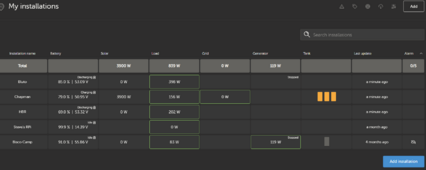KevinC_63559
New Member
Hi.
Just completed phase 1 of my project, with my computer, TV, and a number of related items now running behind a Victron Multiplus II and a pair of 12V LiFePO4 batteries. Thanks to Current Connected for their help. System went together with a limited number of surprises (ferrule crimper needed!) and started right up. Under a full load I should have a bit over 4 hours. Turn off the TV and I'll be closer to 8. Power outage at night and I'll doubt I'll even notice until I see the lights in the morning. Its been a good day.
Phase 2 will be adding a pair of Multiplus IIs and 48V batteries to initially provide UPS to my entire office (which is also home to all the sites internet gear). Phase 3 is adding some solar to the Phase 2 system.
Phase 4 is doing the same thing, on a 2X larger scale, for my house.
Phase 5 is adding solar to Phase 4.
When all is said and done, I'll likely have at least 5 Multiplus II systems, perhaps more running in parallel.
It would be nice to be able to monitor via something like VE Configure from a central location, like my office PC. Is that even possible?
The Victron VE Configure webpage states it can connect to Victron products via Bluetooth, USB and WiFi/LAN/Internet. My office and house share the same LAN and WiFi. How do I go about hooking everything up to my LAN and what would I use software wise? VE Configure appears to only support a single COM port (in my case, via an MK3-USB connector, although that connects via a RJ45 jumper cable (e.g. Standard Cat 5 or above).
I have a bunch of Raspberry Pis laying around if that would help, but it would be cleaner just to be able to plug into my network and open a bunch of windows on my desktop (no worries, I run (3) 3440x1440 monitors, so have monitor pixels to spare).
Just completed phase 1 of my project, with my computer, TV, and a number of related items now running behind a Victron Multiplus II and a pair of 12V LiFePO4 batteries. Thanks to Current Connected for their help. System went together with a limited number of surprises (ferrule crimper needed!) and started right up. Under a full load I should have a bit over 4 hours. Turn off the TV and I'll be closer to 8. Power outage at night and I'll doubt I'll even notice until I see the lights in the morning. Its been a good day.
Phase 2 will be adding a pair of Multiplus IIs and 48V batteries to initially provide UPS to my entire office (which is also home to all the sites internet gear). Phase 3 is adding some solar to the Phase 2 system.
Phase 4 is doing the same thing, on a 2X larger scale, for my house.
Phase 5 is adding solar to Phase 4.
When all is said and done, I'll likely have at least 5 Multiplus II systems, perhaps more running in parallel.
It would be nice to be able to monitor via something like VE Configure from a central location, like my office PC. Is that even possible?
The Victron VE Configure webpage states it can connect to Victron products via Bluetooth, USB and WiFi/LAN/Internet. My office and house share the same LAN and WiFi. How do I go about hooking everything up to my LAN and what would I use software wise? VE Configure appears to only support a single COM port (in my case, via an MK3-USB connector, although that connects via a RJ45 jumper cable (e.g. Standard Cat 5 or above).
I have a bunch of Raspberry Pis laying around if that would help, but it would be cleaner just to be able to plug into my network and open a bunch of windows on my desktop (no worries, I run (3) 3440x1440 monitors, so have monitor pixels to spare).




